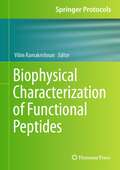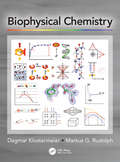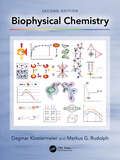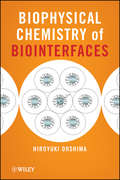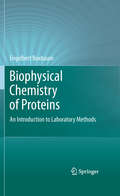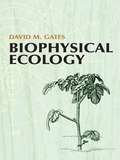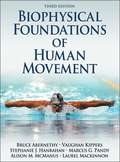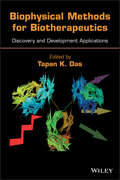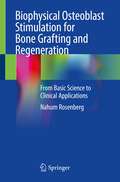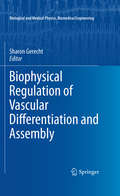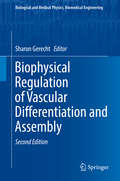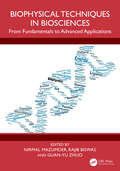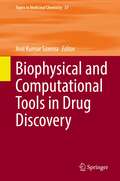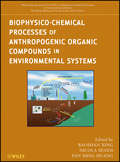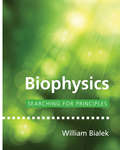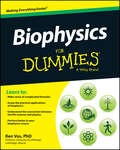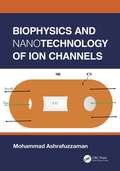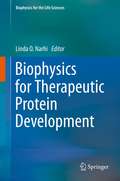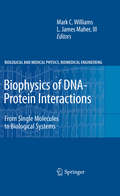- Table View
- List View
Biophysical Applications of Satellite Remote Sensing (Springer Remote Sensing/Photogrammetry)
by Jonathan M. HanesA variety of biophysical applications (e. g. leaf area index and gross primary productivity) have been derived from measurements of the Earth system obtained remotely by NASA's MODIS sensors and other satellite platforms. In Biophysical Applications of Satellite Remote Sensing, the authors describe major applications of satellite remote sensing for studying Earth's biophysical phenomena. The focus of the book lies on the broad palette of specific applications (metrics) of biophysical activity derived using satellite remote sensing. With in-depth discussions of satellite-derived biophysical metrics that focus specifically on theory, methodology, validation, major findings, and directions of future research, this book provides an excellent resource for remote sensing specialists, ecologists, geographers, biologists, climatologists, and environmental scientists.
Biophysical Characterization of Functional Peptides (Springer Protocols Handbooks)
by Vibin RamakrishnanThis protocol book presents reproducible and step-by-step procedures for the peptide synthesis, their characterization and applications. The volume includes an introductory section on in silico modelling of new peptide molecules, Molecular Dynamics Simulations, Docking, Electrostatic fingerprinting of peptides, and other modelling tools for peptide designing and optimization. Further, it covers protocols for the solid phase peptide synthesis, chromatographic and mass spectrometric characterization of peptides. Importantly, it covers methods for biophysical characterizations of peptides for their potential applications as drug delivery vehicles, peptide nano-assembly, bionanocatalysis, protein aggregation diseases, and peptide-based anti-bacterial.
Biophysical Chemistry
by Dagmar Klostermeier Markus G. RudolphBiophysical Chemistry explores the concepts of physical chemistry and molecular structure that underlie biochemical processes. Ideally suited for undergradate students and scientists with backgrounds in physics, chemistry or biology, it is also equally accessible to students and scientists in related fields as the book concisely describes the fundamental aspects of biophysical chemistry, and puts them into a biochemical context. The book is organized in four parts, covering thermodynamics, kinetics, molecular structure and stability, and biophysical methods. Cross-references within and between these parts emphasize common themes and highlight recurrent principles. End of chapter problems illustrate the main points explored and their relevance for biochemistry, enabling students to apply their knowledge and to transfer it to laboratory projects. Features: Connects principles of physical chemistry to biochemistry Emphasizes the role of organic reactions as tools for modification and manipulation of biomolecules Includes a comprehensive section on the theory of modern biophysical methods and their applications
Biophysical Chemistry
by Dagmar Klostermeier Markus G. RudolphBiophysical Chemistry explores the concepts of physical chemistry and molecular structure that underlie biochemical processes. Ideally suited for undergraduate students and scientists with backgrounds in physics, chemistry, or biology, it is also equally accessible to students and scientists in related fields as the book concisely describes the fundamental aspects of biophysical chemistry and puts them into a biochemical context.This second edition has been fully updated throughout with novel techniques, with a new chapter on advances in cryo-electron microscopy and exciting new content throughout on big data techniques, structural bioinformatics, systems biology and interaction networks, and artificial intelligence and machine learning.The book is organized in four parts, covering thermodynamics, kinetics, molecular structure and stability, and biophysical methods. Cross-references within and between these parts emphasize common themes and highlight recurrent principles. End of chapter problems illustrate the main points explored and their relevance for biochemistry, enabling students to apply their knowledge and to transfer it to laboratory projects.Key Features: Connects principles of physical chemistry to biochemistry Emphasizes the role of organic reactions as tools for modification and manipulation of biomolecules Includes a comprehensive section on the theory of modern biophysical methods and their applications
Biophysical Chemistry of Biointerfaces
by Hiroyuki OhshimaThe first book on the innovative study of biointerfaces using biophysical chemistry The biophysical phenomena that occur on biointerfaces, or biological surfaces, hold a prominent place in the study of biology and medicine, and are crucial for research relating to implants, biosensors, drug delivery, proteomics, and many other important areas. Biophysical Chemistry of Biointerfaces takes the unique approach of studying biological systems in terms of the principles and methods of physics and chemistry, drawing its knowledge and experimental techniques from a wide variety of disciplines to offer new tools to better understand the intricate interactions of biointerfaces. Biophysical Chemistry of Biointerfaces: Provides a detailed description of the thermodynamics and electrostatics of soft particles Fully describes the biophysical chemistry of soft interfaces and surfaces (polymer-coated interfaces and surfaces) as a model for biointerfaces Delivers many approximate analytic formulas which can be used to describe various interfacial phenomena and analyze experimental data Offers detailed descriptions of cutting-edge topics such as the biophysical and interfacial chemistries of lipid membranes and gel surfaces, which serves as good model for biointerfaces in microbiology, hematology, and biotechnology Biophysical Chemistry of Biointerfaces pairs sound methodology with fresh insight on an emerging science to serve as an information-rich reference for professional chemists as well as a source of inspiration for graduate and postdoctoral students looking to distinguish themselves in this challenging field.
Biophysical Chemistry of Proteins: An Introduction to Laboratory Methods
by Engelbert BuxbaumThe book is structured in nine sections, each containing several chapters. The volume starts with an overview of analytical techniques and progresses through purification of proteins; protein modification and inactivation; protein size, shape, and structure; enzyme kinetics; protein-ligand interactions; industrial enzymology; and laboratory quality control. The book is targeted at all scientists interested in protein research.
Biophysical Ecology (Dover Books on Biology)
by David M. GatesThis classic and highly influential text presents a uniquely comprehensive view of the field of biophysical ecology. In its analytical interpretation of the ecological responses of plants and animals to their environments, it draws upon studies of energy exchange, gas exchange, and chemical kinetics.The first four chapters offer a preliminary treatment of the applications of biophysical ecology, discussing energy and energy budgets and their applications to plants and animals, and defining radiation laws and units. Succeeding chapters concern the physical environment, covering the topics of radiation, convection, conduction, and evaporation. The spectral properties of radiation and matter are reviewed, along with the geometrical, instantaneous, daily, and annual amounts of both shortwave and longwave radiation. The book concludes with more elaborate analytical methods for the study of photosynthesis in plants and energy budgets in animals, in addition to animal and plant temperature responses.This text will prove of value to students and environmental researchers from a variety of fields, particularly ecology, agronomy, forestry, botany, and zoology.
Biophysical Economy: Theory, Challenges, and Sustainability (Applied Ecology and Environmental Management)
by Steven M. BartellThis book explores the concept of transforming the current macroeconomic system from one based on continuous growth that doesn’t recognize the fundamental importance of Earth's natural support structures, to a system consistent with the basic views of biophysical economics that acknowledges that all real wealth ultimately derives from planetary resources, both renewable and non-renewable. It describes how data and information collected by various institutions, government agencies, and the private sector can be integrated with existing management structures to transform the “continuous growth” economy into an economy that functions within understandable boundaries on a finite planet. Features Stimulates discussions of the feasibility of a biophysical economy. Discusses the historical developments of biophysical economics. Offers a practical approach to building a biophysical economy. Explores the human experience of living in a biophysical economy. Emphasizes the fragility of life in the Universe as we know it. This book is an excellent resource for academics and students studying sustainable development, as well as for professionals working in the private sector and public institutions with an interest in economic planning for a sustainable future.
Biophysical Foundations of Human Movement (3rd Edition)
by Bruce Abernethy Vaughan Kippers Stephanie Hanrahan Marcus Pandy Ali Mcmanus Laurel Mackinnon"Biophysical Foundations of Human Movement, Third Edition," introduces readers to key concepts concerning the anatomical, mechanical, physiological, neural, and psychological bases of human movement. The text provides undergraduate students with a broad foundation for more detailed study of the subdisciplines of human movement and for cross-disciplinary studies. Readers will learn the multi-dimensional changes in movement and movement potential that occur throughout the life span as well as those changes that occur as adaptations to training, practice, and other lifestyle factors. This third edition includes the latest research and improved presentation to address areas of growth and change in the fields of human movement. The following are important updates to this edition: - A new chapter on historical origins of human movement science provides students with an appreciation of the development of the field as well as its future directions. - Content regarding exercise physiology has been reorganized to provide more discrete coverage of key concepts in nutrition. - A new concluding section focuses on applications in the areas of prevention and management of chronic disease, prevention and management of injury, and performance enhancement in sport and the workplace, as well as the benefits of sport and exercise science to work, sport, and everyday living. - Ancillary materials support instructors in teaching across disciplines as they assist students in understanding the breadth of content in this comprehensive text. Using a modular approach to teaching sport and exercise science, "Biophysical Foundations of Human Movement, Third Edition," offers students a structured understanding of how the subdisciplines work independently and in tandem. Following a general introduction to the field of human movement studies, readers are introduced to basic concepts, life-span changes, and adaptations arising in response to training in each of the five major biophysical subdisciplines of human movement. Each subdiscipline is given a brief introduction, including the definition and historical development of the subdiscipline, the typical issues and problems it addresses, the levels of analysis it uses, and relevant professional training and organizations. Multi-disciplinary and cross-disciplinary approaches to human movement are also discussed along with contemporary applications. By studying the integration of knowledge from a number of the biophysical subdisciplines, students will be better prepared for advanced study and careers reliant on the integration of knowledge from various disciplines and perspectives. The third edition offers tools for retaining the material, including learning objectives and summaries in each chapter, a glossary, and lists of web-based resources. Throughout the text, special "In Focus" features highlight key organizations, individuals, and studies from around the world that have contributed to the current understanding of human movement. These features help readers appreciate the evolution of the field so that they may better understand its direction. Students interested in further study will find specialized texts for each of the subdisciplines listed in the Further Reading and References section of each chapter along with updated lists of websites. The third edition of "Biophysical Foundations of Human Movement" offers a comprehensive introduction for students, scientists, and practitioners involved in the many professions grounded in or related to human movement, kinesiology, and sport and exercise science. By considering the effect of adaptations in each of the biophysical subdisciplines of human movement, "Biophysical Foundations of Human Movement" also illustrates the important role physical activity plays in the maintenance of health throughout the life span.
Biophysical Methods for Biotherapeutics
by Tapan K. DasWith a focus on practical applications of biophysical techniques, this book links fundamental biophysics to the process of biopharmaceutical development.* Helps formulation and analytical scientists in pharma and biotech better understand and use biophysical methods * Chapters organized according to the sequential nature of the drug development process * Helps formulation, analytical, and bioanalytical scientists in pharma and biotech better understand and usestrengths and limitations of biophysical methods * Explains how to use biophysical methods, the information obtained, and what needs to be presented in a regulatory filing, assess impact on quality and immunogenicity * With a focus on practical applications of biophysical techniques, this book links fundamental biophysics to the process of biopharmaceutical development.
Biophysical Osteoblast Stimulation for Bone Grafting and Regeneration: From Basic Science to Clinical Applications
by Nahum RosenbergThis book integrates the current basic and clinical knowledge in the area of biophysical stimulation of osteoblast for in vitro and in vivo live bone generation. This innovative methodology and its applications are presented and discussed in several clinical conditions: treatment of fracture nonunion, spine stabilization, bone replacement after tumor resections, stabilization of failed joint endoprostheses in revision surgery and in treatment of bone loss (osteoporosis and osteopenia). The author analyses different types of biophysical stimulation of osteoblasts for bone regeneration, e.g. mechanical (static and alternating, including distraction osteogenesis), electromagnetic (pulsed, alternating, static), light (at different spectrum range, including laser), acoustic (including ultrasound), RF etc. Moreover, he summarizes and discusses the most significant findings for in vitro bone generation and its resulting clinical use as autologous bone graft without surgical morbidity. Reflecting the author’s extensive experience this book is an excellent source of knowledge and a valuable aid to clinical practice for all orthopedic surgeons, fellows, and researchers wanting to gain insights into this promising field.
Biophysical Regulation of Vascular Differentiation and Assembly (Biological and Medical Physics, Biomedical Engineering)
by Sharon GerechtBecause of their ability to differentiate and develop into functional vasculature, stem cells hold tremendous promise for therapeutic applications. However, the scientific understanding and the ability to engineer these cellular systems is still in its early stages, and must advance significantly for the therapeutic potential of stem cells to be realized. Stem cell differentiation and function are exquisitely tuned by their microenvironment. This book will provide a unique perspective of how different aspect of the vasculature microenvironment regulates differentiation and assembly. Recent efforts to exploits modern engineering techniques to study and manipulate various biophysical cues will be described including: oxygen tension during adult and embryonic vasculogenesis (Semenza and Zandstra), extracellular matrix during tube morphogenesis and angiogenesis (Wirtz, Davis, Ingber), surface topography and modification (Chen and Gerecht), shear stress and cyclic strain effect on vascular assembly and maturation (Vunjak-Novakovic and Niklason), and three dimensional space for angio-andvasculogensis (Ferreria and Fischbach).
Biophysical Regulation of Vascular Differentiation and Assembly (Biological and Medical Physics, Biomedical Engineering)
by Sharon GerechtThis book updates and expands on various aspects of the vasculature’s microenvironment and how these regulate differentiation and assembly. Discussed in this new edition are efforts to capitalize on combing engineering techniques, to study and manipulate various biophysical cues, including: endothelial cell- pericyte interactions (Davis), mechanical forces to regulate vascularization in three-dimensional constructs (Levenberg), how matrix properties and oxygen tension regulate vascular fate and assembly (Gerecht), biophysical cues in relation to vascular aging (Ferreira), 3D printing of complex vascularized tissue (Hibino), the harnessing of biophysical cues for therapeutic vasculature interfacing with the damaged brain (Segura) and finally, the infarcted heart (Grayson). This second edition of Biophysical Regulation of Vascular Differentiation and Assembly provides an interdisciplinary view of vasculature regulation thru various biophysical cues and presents recent advances in measuring and controlling such parameters. This book will be of interest to biologists, biophysicists and engineers who work with vascular differentiation and assembly.
Biophysical Techniques in Biosciences: From Fundamentals to Advanced Applications
by Nirmal Mazumder, Rajib Biswas, Guan-Yu ZhuoThis book details the latest advancements in spectroscopic, analytical and imaging techniques, emphasizing their crucial roles in both research and biomedical diagnostics. The initial chapters introduce the fundamental principles of the techniques, highlighting the use of optical spectroscopies for disease diagnosis, such as oral cancer. The book also explores their innovative applications, such as quantitative optical phase imaging, and the examination of biopolymers like starch through spectroscopy and microscopy. Further, the book discusses cutting-edge developments in biomaterials essential for understanding tissue engineering and the innovative use of synthesized bioactive glasses. The chapters also examine revolutionary methods such as HPLC and HPTLC techniques for detailed analysis at unprecedented scales and for observing various processes in health and disease. Importantly, the book reviews the impact of machine learning in enhancing the accuracy of disease diagnoses through nonlinear optical microscopy. The book also presents technological breakthroughs in the transformative impact of these techniques in developing diagnostic and therapeutic solutions. This book is intended for students, researchers, and professionals in biophysics, medical imaging, and biomedical engineering.Key Features: Highlights innovative applications such as quantitative optical phase imaging and the use of spectroscopy in disease diagnosis Explores the fundamental principles of advanced spectroscopic and imaging techniques Demonstrates the role of new technologies like synthesized biomaterials and applications of HPLC techniques Discusses the integration of machine learning with nonlinear optical microscopy to enhance the accuracy of disease diagnoses Presents the latest developments in biomaterials that are revolutionizing tissue engineering
Biophysical and Computational Tools in Drug Discovery (Topics in Medicinal Chemistry #37)
by Anil Kumar SaxenaThis book reviews recent physicochemical and biophysical techniques applied in drug discovery research, and it outlines the latest advances in computational drug design. Divided into 10 chapters, the book discusses about the role of structural biology in drug discovery, and offers useful application cases of several biophysical and computational methods, including time-resolved fluorometry (TRF) with Förster resonance energy transfer (FRET), X-Ray crystallography, nuclear magnetic resonance spectroscopy, mass spectroscopy, generative machine learning for inverse molecular design, quantum mechanics/molecular mechanics (QM/MM,ONIOM) and quantum molecular dynamics (QMT) methods. Particular attention is given to computational search techniques applied to peptide vaccines using novel mathematical descriptors and structure and ligand-based virtual screening techniques in drug discovery research. Given its scope, the book is a valuable resource for students, researchers and professionals from pharmaceutical industry interested in drug design and discovery.
Biophysical approaches to translational control of gene expression (Biophysics for the Life Sciences #1)
by Jonathan D. DinmanThis book provides a premier resource on understanding the ribosome's essential nature and how it interacts with other proteins and nucleic acids to control protein synthesis. As one of the central foundations in our understanding of the biology at the molecular level, this topic appeals to a wide audience, from bench researcher to clinician. With the advent of atomic scale structures, methods to visualize and separate individual molecules, and the computational power to model the complex interactions of over a million atoms at once, our understanding of how gene expression is controlled at the level of protein translation is now deeply ensconced in the biophysical realm.
Biophysico-Chemical Processes of Anthropogenic Organic Compounds in Environmental Systems
by Baoshan Xing Nicola Senesi Pan Ming HuangIn contrast to the classical books which largely focus on separate, individual physicochemical and biological aspects, this book aims to integrate the frontiers of knowledge on the fundamentals and the impact of physicochemical and biological interactions and processes of AOCs in soil, sediment, water and air. The specific objectives of this book are to address: (1) fundamental biophysico-chemical processes of AOCs in the environment, (2) occurrence and distribution of AOCs in air, water, and soil, and their global cycling, (3) the state-of-the-art analytical techniques of AOCs, and (4) restoration of natural environments contaminated by AOCs. The book also identifies the gaps in knowledge on the subject matter and as such provides future directions to stimulate scientific research to advance the chemical science on biophysico-chemical interfacial reactions in natural habitats. By virtue of complex nature of the interactions of AOCs with different environmental components and matrixes, no single available technique and instrument is satisfactory yet for determining their fate, transport, availability, and risk in the environment. In order to fully understand the biophysico-chemical interactions and processes of AOCs in the environment, it is critical to know chemical, physical and biological properties of AOCs and their analytical techniques. The book is unique because of its multidisciplinary approach as it provides a comprehensive and integrated coverage of biophysico-chemical reactions and processes of AOCs in various environments, associated analytical techniques, and restoration of natural environments contaminated by AOCs.
Biophysics
by Patrick F. DillonSpecifically tailored to life science students, this textbook explains quantitative aspects of human biophysics with examples drawn from contemporary physiology, genetics and nanobiology. It outlines important physical ideas, equations and examples at the heart of contemporary physiology, along with the organization necessary to understand that knowledge. The wide range of biophysical topics covered include energetics, bond formation and dissociation, diffusion and directed transport, muscle and connective tissue physics, fluid flow, membrane structure, electrical properties and transport, pharmacokinetics and system dynamics and stability. Enabling students to understand the uses of quantitation in modern biology, equations are presented in the context of their application, rather than derivation. They are each directed toward the understanding of a biological principle, with a particular emphasis on human biology. Supplementary resources, including a range of test questions, are available at www.cambridge.org/9781107001442.
Biophysics
by William BialekInteractions between the fields of physics and biology reach back over a century, and some of the most significant developments in biology--from the discovery of DNA's structure to imaging of the human brain--have involved collaboration across this disciplinary boundary. For a new generation of physicists, the phenomena of life pose exciting challenges to physics itself, and biophysics has emerged as an important subfield of this discipline. Here, William Bialek provides the first graduate-level introduction to biophysics aimed at physics students. Bialek begins by exploring how photon counting in vision offers important lessons about the opportunities for quantitative, physics-style experiments on diverse biological phenomena. He draws from these lessons three general physical principles--the importance of noise, the need to understand the extraordinary performance of living systems without appealing to finely tuned parameters, and the critical role of the representation and flow of information in the business of life. Bialek then applies these principles to a broad range of phenomena, including the control of gene expression, perception and memory, protein folding, the mechanics of the inner ear, the dynamics of biochemical reactions, and pattern formation in developing embryos. Featuring numerous problems and exercises throughout, Biophysics emphasizes the unifying power of abstract physical principles to motivate new and novel experiments on biological systems. Covers a range of biological phenomena from the physicist's perspective Features 200 problems Draws on statistical mechanics, quantum mechanics, and related mathematical concepts Includes an annotated bibliography and detailed appendixes Instructor's manual (available only to teachers)
Biophysics For Dummies
by Ken VosThe fun, easy way to get up to speed on biophysics concepts, principles, and practicesOne of the most diverse of modern scientific disciplines, biophysics applies methods and technologies from physics to the study of biological systems and phenomena, from the human nervous system to soil erosion to global warming. What are the best options for satisfying the world's growing energy demands? How can we feed the world's growing population? How can we contain, or reverse, global warming? How can we vouchsafe a plentiful supply of potable water for future generations? These are among the critical questions to which biophysicists work to provide answers.Biophysics courses are increasingly taken by students of biology, physics, chemistry, biochemistry, physiology, statistics, bioengineering, neuroscience, computer science, pharmacology, agriculture,and many moreProvides a friendly, unintimidating overview of the material covered in a typical college-level biophysics courseA one-stop reference, course supplement and exam preparation tool for university students currently enrolled in an introductory biophysics coursesAn indispensable resource for those studying the natural sciences, biological sciences, and physics, as well as math, statistics,computer science, pharmacology and many other disciplinesThe current job market for people well versed in biophysics is very strong, and biophysics is currently listed as one of the fast-growing occupations in the North America
Biophysics and Nanotechnology of Ion Channels
by Mohammad AshrafuzzamanThis book provides a comprehensive review of the biophysics and nanotechnology of ion channels. It details the biological and physiological entities of ion channels in cells and addresses various physical perspectives of ion channel structures and functions. Naturally inbuilt and artificial applicable nanotechnologies of ion channels are modelled and explored. It discusses various methods that can be utilized toward understanding ion channel-based cellular diseases. Physical, biochemical, biomedical, and bioinformatics techniques are taken into consideration to enable the development of strategies to address therapeutic drug discovery and delivery. This book will be of interest to advanced undergraduate and graduate students in biophysics and related biomedical sciences in addition to researchers in the field and industry. Features: Provides a stimulating introduction to the structures and functions of ion channels of biological cell membranes and discusses the biophysics of ion channels in condensed matter state and physiological condition Addresses natural processes and nanotechnology opportunities for their purposeful manipulation Lays the groundwork for vitally important medical advances Mohammad Ashrafuzzaman, a biophysicist and condensed matter scientist, is passionate about investigating biological and biochemical processes utilizing the principles and techniques of physics. He is an associate professor at King Saud University’s Biochemistry Department of College of Science, Riyadh, Saudi Arabia, the co-founder of MDT Canada Inc., and the founder of Child Life Development Institute, Edmonton, Canada. He also authored Nanoscale Biophysics of the Cell and Membrane Biophysics.
Biophysics and Structure to Counter Threats and Challenges (NATO Science for Peace and Security Series B: Physics and Biophysics)
by Manolia V. Margaris Joseph D. PuglisiThis ASI brought together a diverse group of experts who span virology, biology, biophysics, chemistry, physics and engineering. Prominent lecturers representing world renowned scientists from nine (9) different countries, and students from around the world representing eighteen (18) countries, participated in the ASI organized by Professors Joseph Puglisi (Stanford University, USA) and Alexander Arseniev (Moscow, RU). The central hypothesis underlying this ASI was that interdisciplinary research, merging principles of physics, chemistry and biology, can drive new discovery in detecting and fighting chemical and bioterrorism agents, lead to cleaner environments and improved energy sources, and help propel development in NATO partner countries. At the end of the ASI students had an appreciation of how to apply each technique to their own particular research problem and to demonstrate that multifaceted approaches and new technologies are needed to solve the biological challenges of our time. The course succeeded in training a new generation of biologists and chemists who will probe the molecular basis for life and disease.
Biophysics for Therapeutic Protein Development (Biophysics for the Life Sciences #4)
by Linda O. NarhiThis book can be used to provide insight into this important application of biophysics for those who are planning a career in protein therapeutic development, and for those outside this area who are interested in understanding it better. The initial chapters describe the underlying theory, and strengths and weaknesses of the different techniques commonly used during therapeutic development. The majority of the chapters discuss the applications of these techniques, including case studies, across the product lifecycle from early discovery, where the focus is on identifying targets, and screening for potential drug product candidates, through expression and purification, large scale production, formulation development, lot-to-lot comparability studies, and commercial support including investigations.
Biophysics of DNA
by Alexander VologodskiiSurveying the last sixty years of research, this book describes the physical properties of DNA in the context of its biological functioning. It is designed to enable both students and researchers of molecular biology, biochemistry and physics to better understand the biophysics of DNA, addressing key questions and facilitating further research. The chapters integrate theoretical and experimental approaches, emphasising throughout the importance of a quantitative knowledge of physical properties in building and analysing models of DNA functioning. For example, the book shows how the relationship between DNA mechanical properties and the sequence specificity of DNA-protein binding can be analyzed quantitatively by using our current knowledge of the physical and structural properties of DNA. Theoretical models and experimental methods in the field are critically considered to enable the reader to engage effectively with the current scientific literature on the physical properties of DNA.
Biophysics of DNA-Protein Interactions: From Single Molecules to Biological Systems (Biological and Medical Physics, Biomedical Engineering)
by L. James Maher III Mark C. WilliamsDepite the rapid expansion of the field of biophysics, there are very few books that comprehensively treat specific topics in this area. Recently, the field of single molecule biophysics has developed very quickly, and a few books specifically treating single molecule methods are beginning to appear. However, the promise of single molecule biophysics is to contribute to the understanding of specific fields of biology using new methods. This book would focus on the specific topic of the biophysics of DNA-protein interactions, and would include the use of new approaches, including both bulk methods as well as single molecule methods. This would make the book attractive to anyone working in the general area of DNA-protein interactions, which is of course a much wider market than just single molecule biophysicists or even biophysicists. The subject of the book will be the biophysics of DNA-protein interactions, and will include new methods and results that describe the physical mechanism by which proteins interact with DNA. For example, there has been much recent work on the mechanism by which proteins search for specific binding sites on DNA. A few chapters will be devoted to experiments and theory that shed light on this important problem. We will also cover proteins that alter DNA properties to facilitate interactions important for transcription or replication. Another section of the book will cover the biophysical mechanism by which motor proteins interact with DNA. Finally, we will cover larger protein-DNA complexes, such as replication forks, recombination complexes, DNA repair interactions, and their chromatin context.

